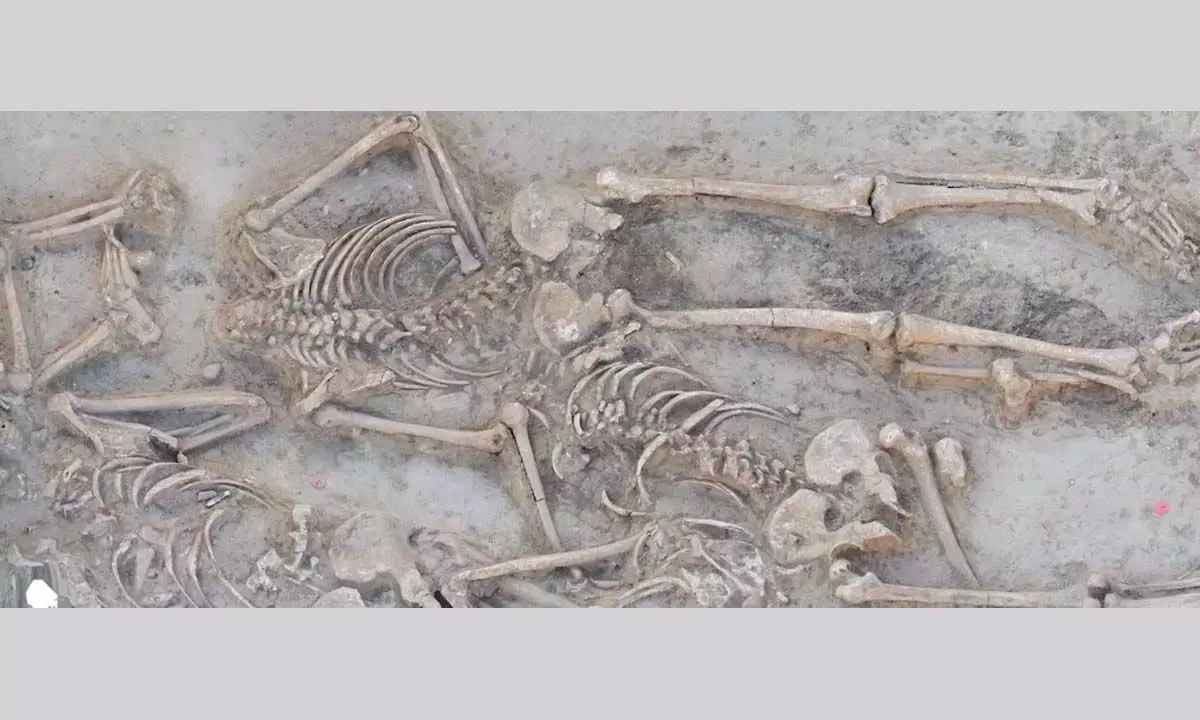Archaeologists Discovered 7,000-Year-Old Mass Grave Containing 38 Beheaded Skeletons In Slovakia

A pair of headless skeletons from a mass grave, lying on their fronts. (Dr. Till Kühl, Institute for Pre- and Protohistoric Archaeology/Kiel University)
- In Slovakia, archaeologists found a mass burial that was 7,000 years old and it contained 38 skeletons.
- Among 38 skeletons, 37 of were beheaded.
In Slovakia, archaeologists found a mass burial that was 7,000 years old and it contained 38 skeletons. Among 38 skeletons, 37 of were beheaded. One of the biggest Neolithic villages in Europe, the Vrable-Velke Lehemby site in Slovakia, is where the bones were discovered.
Early research indicates that the heads were purposely removed after death, the study's author told Insider. Only one youngster under the age of six had a skeleton with an entire skull. Archaeologists are currently attempting to determine why the skulls were removed in such a meticulous manner.
The anthropologist, Katharina Fuchs of Kiel University in Germany, who participated in the dig, claimed that these headless remains distinguished themselves from conventional graves in the same area. She stated that the in the areas of the neck where a forceful beheading occurred, such as in the mediaeval eras with a sword or an axe, you would find cut marks as well as smashed vertebra.
According to early analysis of the bones, the decapitations were probably done on purpose. She said that the first vertebra, located directly beneath the head, was intact on the individuals that had been preserved sufficiently to still have visible neck bones. This shows that rather than being severed during conflict, the heads were chopped off using incredibly sharp tools.
This is possible because locals have access to obsidian, a rock that when fractured is razor sharp.
Martin Furholt, the project's leader and a professor of prehistory and social archaeology at Kiel University, said in an email to Insider that it is unknown whether the head was removed before or after death. There are numerous accounts of Neolithic people dismembering bodies after they died and removing the heads. She remarked that people often buried those heads in their houses, or may have deposited at some other places.
Katharina Fuchs states that it is also conceivable that the removal of these skulls was a coercive act of war or intimidation. She added that there is a possibility that this killing event will result in the heads being taken as trophies and displayed, for example, on the palisades. They are unable to rule that out. After all, despite being highly developed farming societies, evidence indicates that they might have been harsh.
Talheim and Herxheim are two further noteworthy mass graves in the region. 34 men, women, and children's bones are unearthed at the Talheim site in Germany, which provides evidence of a horrific battle. The victims are believed to have been murdered by a nearby community and then left to decompose. At least 450 people were discovered in a ditch at the Herxheim site, also in Germany, entirely dismembered with cut marks on the bones and skulls. This shows that before the dead were buried in the pit, flesh was removed from the bones.
Not the first headless bodies to be discovered in the ditch, however. A few more headless skeletons had been found during earlier digs, but they had been scattered considerably more thinly and had been mixed with more common burials. Fuchs claimed that's why the finding of such a sizable collection of headless remains came as a complete shock.
There could be even more corpses buried there. Fuchs claimed that due to their excavation being limited to just over five weeks, they had to cease. However, bones unearthed at the grave's edge imply that it goes deeper than what they have discovered.



















